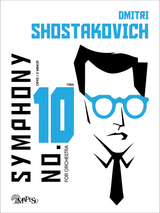
Shostakovich’s Symphony No. 10 in E minor, Op. 93, completed in 1953, is one of his most profound and powerful works. Written after Stalin’s death, it is often interpreted as a reflection on the oppressive Soviet regime and the composer’s personal struggles. The symphony is structured in four movements, contrasting darkness and violence with moments of lyricism and defiance.
The first movement (Moderato) is a vast, brooding expanse, characterized by slow, melancholic themes that gradually build in intensity. It develops through haunting woodwind solos, dramatic climaxes, and a relentless sense of tension. The second movement (Allegro) is a short, brutal scherzo, marked by violent rhythms and aggressive brass writing, often thought to represent Stalin’s oppressive rule.
The third movement (Allegretto) introduces Shostakovich’s DSCH motif (D–E♭–C–B), a musical signature representing his name. This personal theme interacts with a lyrical horn motif, possibly symbolizing Elmira Nazirova, a musician Shostakovich admired. The interplay between these themes adds a layer of introspection and coded personal meaning.
The finale (Andante – Allegro) begins with a mysterious introduction before transforming into a lively, almost sarcastic dance. The DSCH motif reappears triumphantly, suggesting resilience and personal victory. The symphony ends with a sense of defiant energy, leaving its exact message open to interpretation but undeniably affirming Shostakovich’s complex relationship with his time and surroundings.
- Difficulty:
- Advanced
- Instrumentation:
- Picc, 2Fl(1dPicc2), 3Ob(1dCA), 3Cl(1dPicc Cl), 3Bsn(1d Cbsn), 4Hn, 3Tpt, 3Tbn, Tba, Timp, Perc, Strings
- Duration:
- 50-60 minutes
- Set of Parts:
- Includes Strings count 4.4.3.3.2
- Extra Strings (highly recommended, this is a very large work):
- Only available with the purchase of the Set of Parts






